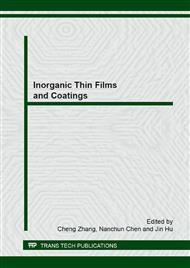p.32
p.36
p.42
p.46
p.52
p.58
p.63
p.67
p.71
Ceramic Coating of TiC-TiB2 on 1Cr18Ni9Ti Substrate Achieved by Combustion Synthesis in High-Gravity Field
Abstract:
Based on fusion bonding of liquid TiC-TiB2 ceramic film to stainless steel substrate of 1Cr18Ni9Ti, the ceramic coating on stainless steel substrate was achieved in graded composition by combusion synthesis in high-gravity field. XRD, FESEM and EDS results showed the ceramic coating was composed of a number of fine TiB2 platelets, irregular TiC grains and a few of Cr metallic binder and the inclusions of Al2O3 partilces, and physical and mechanical properties showed density, relative density, microhardness and fracture toughness of the ceramic coating were 4.25 g • cm-3, 98.2%, 24.6 GPa and 14.5 ± 3.5 MPa • m0.5, respectively. The joint of TiC-TiB2 ceramic coating on stainless steel substrate consisted of 3-layer structures, i.e. the ceramic coating, the intermediate and stainless steel substrate, and within the intermediate of Fe-Cr-Ni-Ti metallic matrix Ti-Fe enriched carbides decreased gradually both in volume fraction and particle size from the ceramic coating to stainless steel substrate in the presence of atomic unidirectional diffusion of Ti and C, while some isolated α-Al2O3 fine particles were also observed in the intermediate besides the presence of both some coarsened α-Al2O3 inclusions nearby the ceramic coating and the barrier layers of Al2O3 between the ceramic and the intermediate, so it is considered that the ceramic coating on stainless steel substrate is achieved partially by fusion bonding due to the poor incompatibilities between Al2O3 inclusions and the intermediate, resulting in the moderate shear strength of 125 ± 35 MPa between the ceramic coating and stainless steel substrate.
Info:
Periodical:
Pages:
52-57
Citation:
Online since:
January 2013
Authors:
Price:
Сopyright:
© 2013 Trans Tech Publications Ltd. All Rights Reserved
Share:
Citation:


